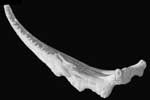This specimen was collected by Blair in 1952 in Paraunuwear Canyon in Hurricane, Utah. It resides in the Texas Natural History Collections of the Texas Memorial Museum (TNHC 18496). It was made available to the University of Texas High-Resolution X-ray CT Facility for scanning by Dr. Wendy L. Hodges of the Department of Biology, University of California, Riverside. Funding for scanning was provided by a National Science Foundation grant (DBI-0204459) to Dr. Hodges. Funding for image processing was provided by a National Science Foundation Assembling the Tree of Life grant (EF-0334961), The Deep Scaly Project: Resolving Squamate Phylogeny using Genomic and Morphological Approaches, to Drs. Jacques Gauthier of Yale University, Maureen Kearney of the Field Museum, Jessie Maisano of The University of Texas at Austin, Tod Reeder of San Diego State University, Olivier Rieppel of the Field Museum, Jack Sites of Brigham Young University, and John Wiens of SUNY Stonybrook.

Literature
Frost, D. R., and R. Etheridge. 1989. A phylogenetic analysis and taxonomy of iguanian lizards (Reptilia: Squamata). University of Kansas Museum of Natural History Miscellaneous Publication 81.
Pianka, E. R., and W. S. Parker. 1975. Ecology of horned lizards: A review with special reference to Phrynosoma platyrhinos Copeia 1975:141-162.
Presch, W. 1969. Evolutionary osteology and relationships of the horned lizard genus Phrynosoma (Family Iguanidae) Copeia 1969:250-275.
Reeve, W. L. 1952. Taxonomy and distribution of the horned lizard genus Phrynosoma. University of Kansas Science Bulletin 34:817-960.
Smith, H. M. 1946. Handbook of Lizards: Lizards of the United States and of Canada. Comstock Publishing Co., Ithaca, New York.
Links
More on horned lizards from Eric Pianka and Wendy Hodges
Phrynosoma platyrhinos page on the Digital Atlas of Idaho
P. platyrhinos page from the USGS Western Ecological Research Center
The Horned Lizard Conservation Society
















